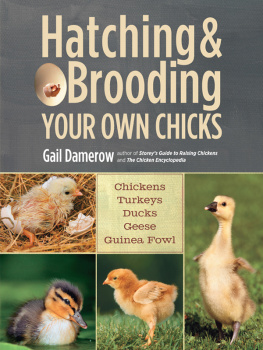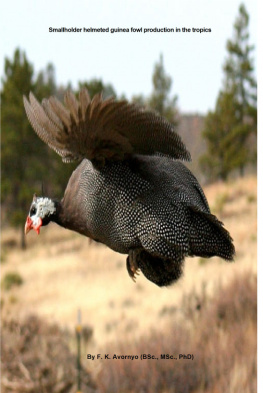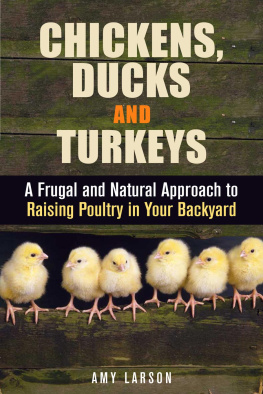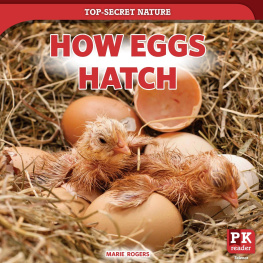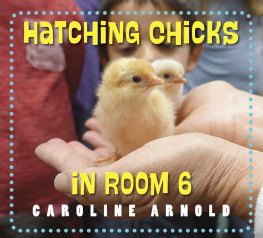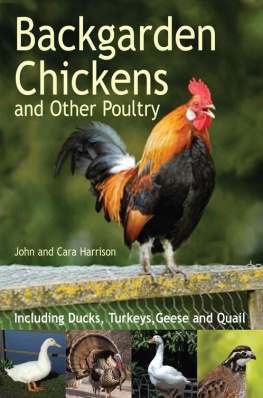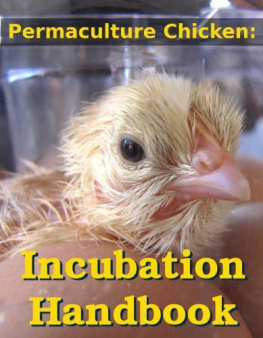

Hatching & Brooding Your Own Chicks

The mission of Storey Publishing is to serve our customers by publishing practical information that encourages personal independence in harmony with the environment.
Edited by Deborah Burns and Rebekah Boyd-Owens
Art direction and book design by Mary Winkelman Velgos
Text production by Jennifer Jepson Smith
Cover photography by Arco Martin/Getty Images: front, right; fotolincs/Alamy: front, bottom left; Fuse/Getty Images: front, center; Gail Damerow: back, left two eggs; Mark Mosrie: back, author; Mars Vilaubi: back, right two eggs; Photoshot/Alamy: front, top left; Photoshot/Ernie James: front, title
Interior photography credits appear on
Illustrations by Bethany Caskey, except for chart, , by Ilona Sherratt
Indexed by Samantha Miller
2013 by Gail Damerow
All rights reserved. No part of this book may be reproduced without written permission from the publisher, except by a reviewer who may quote brief passages or reproduce illustrations in a review with appropriate credits; nor may any part of this book be reproduced, stored in a retrieval system, or transmitted in any form or by any means electronic, mechanical, photocopying, recording, or other without written permission from the publisher.
The information in this book is true and complete to the best of our knowledge. All recommendations are made without guarantee on the part of the author or Storey Publishing. The author and publisher disclaim any liability in connection with the use of this information.
Storey books are available for special premium and promotional uses and for customized editions. For further information, please call 1-800-793-9396.
Storey Publishing
210 MASS MoCA Way
North Adams, MA 01247
www.storey.com
Printed in the United States by Quad Graphics
10 9 8 7 6 5 4 3 2 1
Library of Congress Cataloging-in-Publication Data
Damerow, Gail.
Hatching & brooding your own chicks / by Gail Damerow.
p. cm.
Includes index.
ISBN 978-1-61212-014-0 (pbk. : alk. paper)
1. Poultry. 2. Chicks. I. Title. II. Title: Hatching and brooding your own chicks.
SF495.D36 2013
636.5dc23
2012013937
CONTENTS

INTRODUCTION
Which comes first , the chicken or the egg? I mulled over this conundrum while deciding how to organize this book. A certain logic seems to dictate starting with eggs and incubation. But that entails an awfully steep learning curve for the poultry-keeping newbie.
Because the more common scenario is to start a flock with chicks from the local farm store or ordered by mail, I chose to begin this book with details on acquiring and brooding chicks. By the time the pullets start laying, you are comfortable with brooding and raising chicks, and excited by the possibility of hatching some of their eggs.
Other folks start out with grown-up hens, as did I. When I bought my first house, I wanted to make sure it was zoned for chickens, and what better way than to buy a place that came with hens already installed! Come spring I was at the farm store, heard peeping, and couldnt help bringing home a boxful of fluffy chicks to raise. The folks at the store provided helpful information on how to brood chicks in a cardboard box using a light bulb for heat. What they didnt point out is how fast chicks grow, and how soon they need a bigger and then an even bigger cardboard box.

CHICKS HAPPEN
While I was brooding those chicks, I noticed that one of the buff bantam hens that came with the house had disappeared. Lo and behold, one day she reappeared, trailing a dozen fluffy yellow peepers. How did that happen? And hey why cant I hatch chicks from my own hens instead of buying them at the farm store?
So began my quest to learn all about hatching the eggs of not only my chickens but also the ducks, geese, guineas, and turkeys that have populated my barnyard over the years. Pretty soon I became known as the lady with chickens in her living room not the greatest idea because of all the dust baby birds make. One day I lucked out and ran across a used galvanized box brooder at a reasonable price, which allowed me to safely brood hatchlings in the garage. Later I found a deal on a couple of battery brooders, which let me brood greater quantities of birds. I was in poultry heaven. My husband and I have since made a wide variety of brooders and have settled on custom designs that work best for us in our situation.
Meanwhile I learned how lucky I was to have a setting hen so early in the game, as not all modern hens are into motherhood. I have since looked after many a broody hen and her hatchlings and still occasionally get surprised by a stealth setter. discusses the ins and outs of working with setting hens.
I have also learned to use a variety of incubators, starting with the minimalist galvanized steel models affectionately known as tin hens once sold by Sears, Roebuck, and working my way through an array of tabletop and cabinet incubators of many shapes, sizes, and features.
WHY HATCH AND NOT BUY?
So why would anyone bother hatching eggs in an incubator when hatchlings are so readily available from local breeders, farm stores, and mail order? Here are some of the many reasons:
You wish to maintain a sustainable flock that acclimates to your particular locale
You are working to restore an endangered breed
Your chosen breed may not feature reliable setters or good mothers
Your facilitys conditions may not encourage broodiness
Local wildlife or household pets may disturb the hens nests
You may wish to keep your hens laying, which stops when they start setting
You are trying to produce the perfect show bird
You want to raise hatchlings outside the normal brooding season
You want more hatchlings than your hens are able to hatch
You are seeking a fun and educational activity for your children or students
The decision to use a mechanical incubator is not necessarily either/or. I let my hens set whenever one gets the urge because I enjoy the sight of a hen with chicks. I use an incubator when I need a large number of chicks, such as to raise pullets as replacements for old layers and to replenish our familys broiler supply with the excess cockerels.
And sometimes combining brooding with artificial incubation makes sense, such as when a setting hen leaves the nest early, falls victim to a predator in midterm, or makes her nest in an unsafe environment for hatchlings. In such cases gathering up the started eggs and finishing the hatch in an incubator can save the day.
Between the fun of maintaining a breeder flock (or otherwise acquiring fertile eggs of the sort you want) and the joy of raising your own baby poultry comes a 3-to-4-week period of anticipation while you wait for the hatchlings to appear. Even old pros experience pangs of anxiety during this waiting period, because we know mostly from past experience all the things that can go wrong.
Next page
